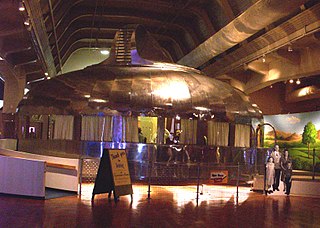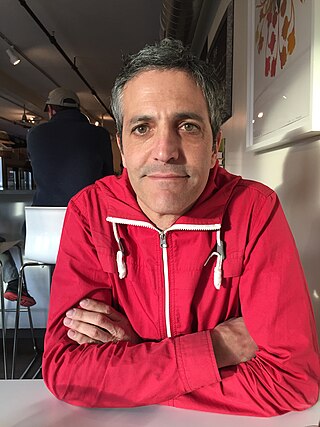
Richard Buckminster Fuller was an American architect, systems theorist, writer, designer, inventor, philosopher, and futurist. He styled his name as R. Buckminster Fuller in his writings, publishing more than 30 books and coining or popularizing such terms as "Spaceship Earth", "Dymaxion", "ephemeralization", "synergetics", and "tensegrity".

A geodesic dome is a hemispherical thin-shell structure (lattice-shell) based on a geodesic polyhedron. The triangular elements of the dome are structurally rigid and distribute the structural stress throughout the structure, making geodesic domes able to withstand very heavy loads for their size.

The Dymaxion House was developed by inventor and architect Buckminster Fuller to address several perceived shortcomings with existing homebuilding techniques. Fuller designed several versions of the house at different times—all of them factory manufactured kits, assembled on site, intended to be suitable for any site or environment and to use resources efficiently. A key design consideration was ease of shipment and assembly.

The Dymaxion map or Fuller map is a projection of a world map onto the surface of an icosahedron, which can be unfolded and flattened to two dimensions. The flat map is heavily interrupted in order to preserve shapes and sizes.

The Dymaxion car was designed by American inventor Buckminster Fuller during the Great Depression and featured prominently at Chicago's 1933/1934 World's Fair. Fuller built three experimental prototypes with naval architect Starling Burgess – using donated money as well as a family inheritance – to explore not an automobile per se, but the 'ground-taxiing phase' of a vehicle that might one day be designed to fly, land and drive – an "Omni-Medium Transport". Fuller associated the word Dymaxion with much of his work, a portmanteau of the words dynamic, maximum, and tension, to summarize his goal to do more with less.
World Game, sometimes called the World Peace Game, is an educational simulation developed by Buckminster Fuller in 1961 to help create solutions to overpopulation and the uneven distribution of global resources. This alternative to war games uses Fuller's Dymaxion map and requires a group of players to cooperatively solve a set of metaphorical scenarios, thus challenging the dominant nation-state perspective with a more holistic "total world" view. The idea was to "make the world work for 100% of humanity in the shortest possible time through spontaneous cooperation without ecological damage or disadvantage to anyone," thus increasing the quality of life for all people.

James Tennant Baldwin, often known as Jay Baldwin or J. Baldwin, was an American industrial designer and writer. Baldwin was a student of Buckminster Fuller; Baldwin's work was inspired by Fuller's principles and, in the case of some of Baldwin's published writings, he popularized and interpreted Fuller's ideas and achievements. In his own right, Baldwin was a figure in American designers' efforts to incorporate solar, wind, and other renewable energy sources. In his career, being a fabricator was as important as being a designer. Baldwin was noted as the inventor of the "Pillow Dome", a design that combines Buckminster Fuller's geodesic dome with panels of inflated ETFE plastic panels.
R. Buckminster Fuller coined the term design science revolution to describe his proposed scientific and socio-economic revolution accomplished by shifting from "weaponry to livingry" through the application of what he called comprehensive anticipatory design science. His World Design Science Decade, proposed to the International Union of Architects in 1961, was an attempt to catalyze the revolution.
A concept of design science was introduced in 1957 by R. Buckminster Fuller who defined it as a systematic form of designing. He expanded on this concept in his World Design Science Decade proposal to the International Union of Architects in 1961. The term was later used by S. A. Gregory in the 1965 'The Design Method' Conference where he drew the distinction between scientific method and design method. Gregory was clear in his view that design was not a science and that design science referred to the scientific study of design. Herbert Simon in his 1968 Karl Taylor Compton lectures used and popularized these terms in his argument for the scientific study of the artificial. Over the intervening period the two uses of the term have co-mingled to the point where design science may have both meanings: a science of design and design as a science.
Alice Rawsthorn OBE is a British design critic and author. Her books include Design as an Attitude (2018) and Hello World: Where Design Meets Life (2013). She is chair of the board of trustees at the Chisenhale Gallery in London and at The Hepworth Wakefield gallery in Yorkshire. Rawsthorn is a founding member of Writers at Liberty, a group of writers who are committed to supporting the work of the human rights charity Liberty. She was appointed Officer of the Order of the British Empire (OBE) in the 2014 Birthday Honours for services to design and the arts.
Medard Gabel is the executive director of the non-profit research and development organization EarthGame. He also leads BigPictureSmallWorld and the Global Solutions Lab. He is the former executive director of the World Game Institute and director of The Cornucopia Project and the Regeneration Project at Rodale Press. He has done work for Tanzania on regenerative agriculture, as well as work in Costa Rica, Spain, The Netherlands, Japan, China, Malaysia and elsewhere. He has written six books on world food and energy problems and solutions, the U.S. food system, multinational corporations, and strategic planning.

Metropolis is an internationally recognised design and architecture–concentrated magazine with a strong focus on ethics, innovation and sustainability in the creative sector. The magazine was established in 1981 by Horace Havemeyer III of Bellerophon Publications, Inc alongside his wife Eugenie Cowan Havemeyer and is based in New York City. Metropolis’s work towards future focused is based in their motto “design at all scales”.
Evan Mather is an American landscape architect, urban designer, and filmmaker. He is primarily known for his work in the genre of web film specifically the reconfiguration of personal histories and exploration of memory landscapes.
The most successful web-stream films, of course, are made with the format in mind. American film-maker Evan Mather's work, such as Icarus of Pittsburgh (2002), is a good example: densely packed with visual and aural information, his films seem made to be watched intently, in isolation and cocooned by headphones.

Sam Green is an American documentary filmmaker. His most recent projects are “live documentaries” in which he narrates a film in-person while musicians perform a live soundtrack. His 2018 project A Thousand Thoughts features a live score by the Kronos Quartet, and his 2012 project The Love Song of R. Buckminster Fuller featured a live score by the band Yo La Tengo. Green's 2004 film The Weather Underground was nominated for an Academy Award, included in the Whitney Biennial, and broadcast nationally on PBS.
Rick (Richard) Cook is a New York City architect best known for designing the Bank of America Tower at One Bryant Park, a 2,100,000-square-foot (200,000 m2) skyscraper that is the first commercial high rise to receive the United States Green Building Council's Leadership in Energy and Environmental Design (LEED) Platinum Certification.
Blue Ventures is a social enterprise and registered charity focused on nurturing locally led marine conservation. The organisation partners with coastal communities that depend on marine resources.

The Last Dymaxion: Buckminster Fuller’s Dream Restored is a 2012 documentary film directed by Noel Murphy. about Buckminster Fuller's 1933 Dymaxion car as well as Fuller himself.
Jason F. McLennan is an architect and prominent figure in the green building movement. He is the founder, former chair, and current board member of the International Living Future Institute and Cascadia Green Building Council, a chapter of both the United States Green Building Council and the Canada Green Building Council. He is the CEO of McLennan Design, his own architecture and planning firm that does work all over the world. McLennan is also the creator of Pharos, an advanced building material rating system, Declare, an ingredient disclosure label for building products, and JUST, a social justice transparency platform for organizations. In addition, he developed the Living Community Challenge and Living Product Challenge. Additionally, McLennan formerly served as the chief innovation officer for Integral Group.

Martin Felsen is an American architect and Fellow of the American Institute of Architects (FAIA). He directs UrbanLab, a Chicago-based architecture and urban design firm. Felsen's projects range in scale from houses such as the Hennepin, Illinois Residence, mixed-use residential and commercial buildings such as Upton's Naturals Headquarters, public open spaces such as the Smart Museum of Art Courtyard at the University of Chicago, and large scale, urban design projects such as Growing Water in Chicago and a masterplan for the Yangming Lake region of Changde, China. Felsen was awarded the 2009 Latrobe Prize by the American Institute of Architects, College of Fellows.
The Fly's Eye Dome was a structure designed in 1965 by R. Buckminster Fuller. Inspired by the eye of a fly, Fuller designed the dome as his idea of the affordable, portable home of the future, with windows and openings in the dome to hold solar panels and systems for water collection, thus allowing the dome to be self sufficient. Before his death in 1983, he hand-built three prototypes of the design:










